
views
Finding a Mantra and Setting Intentions

Figure out why you want to use mantra meditation. Every person has a different reason for meditating from health benefits to attaining a spiritual connection. Figuring out why you want to use mantra meditating will help you identify the best mantras to chant and time to dedicate to your meditation practice. There are many different health benefits to mantra meditation including lower blood pressure and heart rate, decreased anxiety and depression, less stress, and greater feelings of relaxation and general well-being. Mantra meditation can also have spiritual benefits such as liberating your mind and letting go of any attachment to things you can’t control.
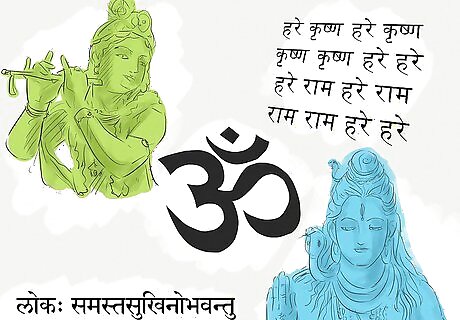
Find an appropriate mantra or mantras for your intention. One of the goals of chanting mantras is to feel their subtle vibrations. This sensation can help you effect positive changes and enter a deep state of meditation. Each mantra has different vibrations and you want to find one that corresponds to your intention. Repetition of mantras can help you disconnect from any thoughts that arise during meditation and also help keep you focused on your intention. There are many different mantras from which you can choose. The following are a few examples of powerful mantras that you can chant. Om or aum is the most basic and powerful mantra you can chant. This universal mantra will create powerful, positive vibrations in your lower abdomen. It is often combined with the mantra “Shanti,” which means peace in Sanskrit. You can repeat aum as many times as you wish for your chanting. Maha mantra, which is also called either the great mantra or Hare Krishna mantra, can help you achieve salvation and peace of mind. Repeat the entire mantra as many times as you like. It’s words are: Hare Krishna, Hare Krishna, Krishna Krishna, Hare Hare, Hare Rama, Hare Rama, Rama Rama, Hare Hare. Lokah samastah sukhino bhavantu is a mantra of cooperation and compassion and means “May all beings everywhere be happy and free, and may the thoughts, words, and actions of my own life contribute in some way to that happiness and to that freedom for all.” Repeat this mantra three or more times. Om namah shivaya is a mantra that reminds every person of her own divinity and encourages self-confidence and compassion. It means “I bow to Shiva, the supreme deity of transformation who represents the truest, highest self.” Repeat the mantra three or more times.
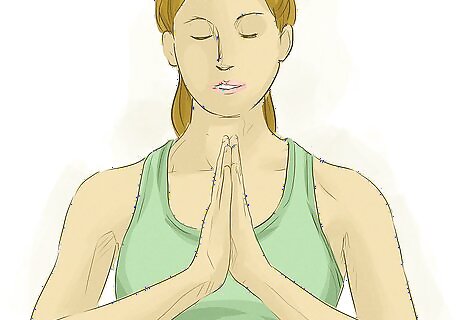
Set an intention. No mantra meditation practice is complete without first setting an intention. By taking a few seconds to dedicate your practice to something, you may be able to focus more intently and achieve a deeper state of meditation. Lightly touch the bases of your palms, then the palms themselves, and finally your fingers to make prayer hands. You can leave a small space between your palms if you like to let energy flow. Lightly bow your chin towards your chest. If you don’t know what your intention is, consider something as simple as “letting go.”
Practicing Chanting and Meditating

Find a comfortable place to practice. You’ll want to practice mantra meditation in a comfortable and quiet space. This can be somewhere in your home, or even in places such as a yoga studio or church. Look for a somewhat darker place to practice meditating so that you don’t get overstimulated from the light. Make sure the place you practice your mantra meditation is quiet so that no one can disturb you or break your concentration.

Sit in a comfortable cross legged-position with elevated hips and closed eyes. Before you begin your mantra meditation, sit in a comfortable cross-legged position with your hips elevated above your knees with your eyes closed. This will help you sit with a straight spine, which is the best position for your body to absorb the mantra’s vibrations and focus on your intention. If you can’t get your hips above your knees, sit on as many blocks or folded blankets as necessary until you achieve this position. Place your hands lightly on your thighs. If you like, you can place one hand in chin or gyan mudra, which represents universal consciousness. Chin mudra and prayer beads may help you enter a deeper meditation. Use prayer or mala beads to help focus yourself.

Focus on your breath, but don’t control it. Focus on your breath and the feeling of each inhalation and exhalation while avoiding the tendency to control your breath. This will help you focus on your meditation practice and achieve greater relaxation. It can be hard to not control your breath, but learning to let it go will help your overall meditation practice. The more you practice, the easier this will get.
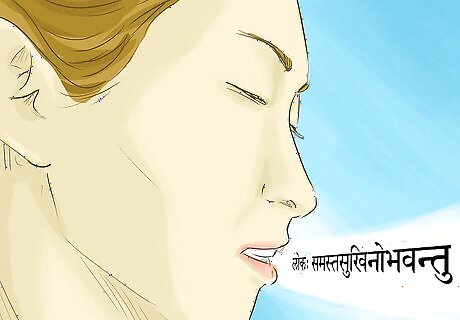
Chant your chosen mantra. It’s time to chant your chosen mantra! There are no prescribed times or ways to chant your mantra, so do what feels best to you. Even a small amount of mantra chanting can have significant benefits. Consider starting your chant with an aum, which is the most elemental sound. As you chant, you should feel mantra’s vibrations in your lower belly. If you can’t feel this sensation, try sitting up straighter. There are different perspectives on correct pronunciation, but simply do your best with the Sanskrit. You’re chanting and meditating for your well-being and not perfection, which may subvert the reason you’re practicing.
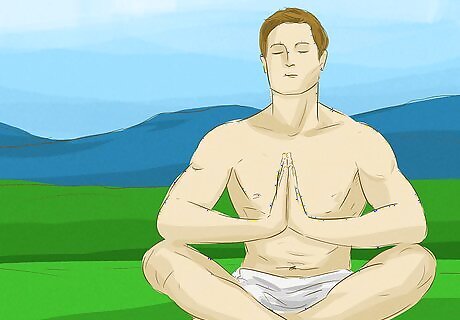
Decide if you want to continue chanting or silently meditate. Chanting itself can be a form of meditation, but you can also choose to transition from chanting meditation to a silent meditation. Either choice you make, you will reap the benefits of a mantra meditation practice. Allow your body to flow with what it wants and whatever works for you in the moment. There are times when you may want to continue chanting or other times when you will want to meditate silently. The point is to not force your body or your mind.
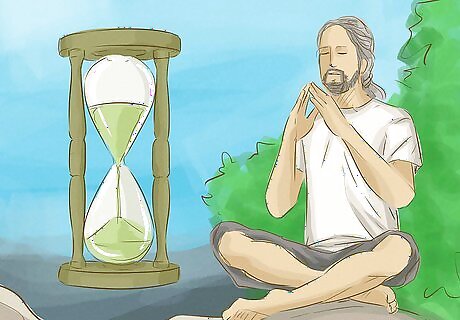
Meditate for as long as you want. When you’ve finished chanting your mantra, transition to a silent meditation by staying in the same seated position and feeling any sensations that arise in your body. Sit in silent meditation for as long as you like. This will allow you focus on your intention and help you achieve greater relaxation. Continue to focus on your inhalations and exhalations and any lingering vibrations from your mantra chanting. Let your thoughts come and whenever they arise. This will teach you to focus and let go of anything you can’t control. Any time you need to refocus your mind, you can repeat “let” with every inhalation and “go” with every exhalation. Meditation takes consistent practice. You will have good days and bad days and accepting this is part of the meditation journey.




















Comments
0 comment